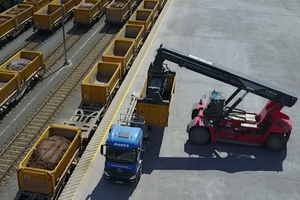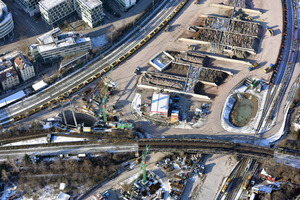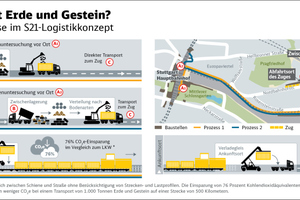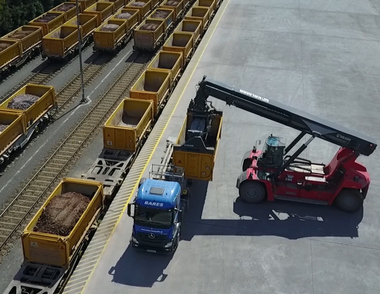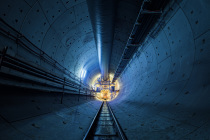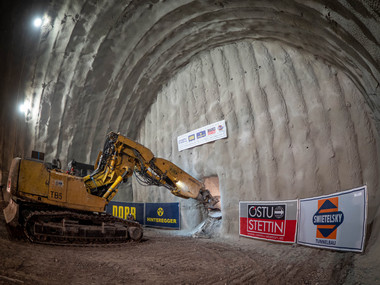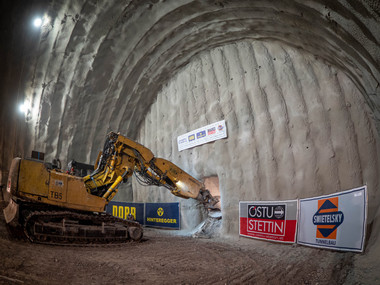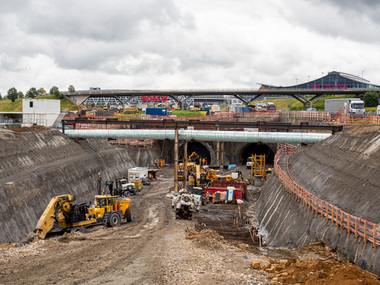Stuttgart 21: Transport of 8 Million Tonnes of Spoil
“Half of our job is done now and the end of the transport is foreseeable", stated Wolf-Dieter Tigges, manager of the central construction logistics (ZBL) on the DB project Stuttgart–Ulm. His department has been responsible since June 2014 for the carting away of material produced by the inner-city construction sites of the future rail node in Stuttgart. On 24 April 2017, the 4000th train departed from the handling area of the construction logistics department at the north station – meaning that four of the eight million tonnes of earth and rock have now been transported away from the sites of the main station and adjacent tunnels.
40 Million Tonnes of Spoil on the Overall Project
Altogether about 20 million tonnes will be produced by the part project Stuttgart 21. The eight million tonnes to be transported through the central construction logistics department come from the project sections 1.1 (Valley crossing with main station), 1.2 (Filder Tunnel), 1.5 (Feeders to Feuerbach and Bad Cannstatt with S-Bahn urban transit) und 1.6a (Feeders to Ober- and Untertürkheim). In addition, about twelve million tonnes of spoil are disposed of directly by the contractors for the currently decentralised logistics areas of Filder and Neckar. A further 20 million tonnes of spoil will be produced by the new line from Wendlingen to Ulm, which will also have to be disposed of by the responsible contractors.
Logistic System with intermodal Containers for Road and Rail
One train can transport about 1000 tonnes of spoil, and at peak times up to 13 trains depart from the ZBL site each day. “The movement of such a quantity of soil and rock in such a restricted space has never occurred before on a major project for German Railways DB”, explains Tigges. Also unique is the overall concept of construction logistics, with a system of intermodal containers having been developed for combined transport by road and rail. This system should also be used in the future DB projects. With the use of the yellow intermodal containers, which can be mounted on rail cars or roadgoing trucks, the earth is transported away efficiently in an environmentally acceptable manner. The major part of the transprort is handled by rail. Trucks do not have to drive long distances and the handling processes between the transport vehicles are reduced, with a saving of time and CO2. The team and the project manager Tigges were awarded an internal commendation for this work in 2016.
Classification of the Spoil
In the most favourable case, soil and rock has already been tested and categorised on site and loaded into the appropriate container. From the site, each container goes directly to the departure location of the trains. On some sites, however, it is not possible to perform testing, and the categorisation first starts at an intermediate storage location. After categorisation at the storage location, the material travels to the departure location in a yellow container, where a special fork lift (reach stacker) simply loads the container from the truck onto the train. When it arrives at the destination, the containers can once again be placed onto trucks without problems – all without time-intensive reloading. The handling area at the north station is generously sized, with two loading areas and several departure tracks. This even ensures the security of disposal at peak times.
Construction Logistics on DB Land
The ZBL (handling area and haul roads) is mostly sited on DB land, for which purpose the goods track between Stuttgart Nord and the main station was removed. Later, the state capital Stuttgart will use these areas for urban development.
The trucks used for the transport of spoil hardly used public roads but travel on extra haul roads. The roads into the city centre, which already carry heavy traffic, see scarcely any additional traffic.
Protection of the Inhabitants around the Site
DB has implemented special noise protection measures. A 4m high noise protection barrier has been erected at the Rosensteinstraße along the haul road running from the city centre to the handling area. The local inhabitants win twice from this measure because the noise protection barrier also considerably reduces the noise from regular train services.
The emission of dust and light from the site also proved to be a problem for the local inhabitants, explains Wolf-Dieter Tigges: “The project has undertaken a lot to combat this: the lighting concept is adapted to suit the requirements; after 22:00 there is no more light and no light is switched on before 7:00. Appropriate measurement points have been set up to measure dust and provide us with an overview at all times what emissions are occurring.”
Reduced Output of Greenhouse Gases
Goods trains up to 400 m long, each with about 20 goods wagons, run to the landfill sites of the recycling locations. On average, one train journey saves about 40 truck journeys, which saves 76 per cent carbon dioxide equivalent (CO2e). The overall environmental comparison between road and rail, which does not taken into account any route or load profile, calculates a saving of about 30 tonnes of CO2e for the rail transport of 1000 tonnes of earth and rock over a distance of 500 km.
Reuse of the Tunnel Spoil
The rock and soil, which is removed from the inner-city sites of the main station and the tunnel construction, includes valuable raw materials for other major construction works or for ecological recycling. German railways delivered, for example, S21 material to the “State Garden Show” Landesgartenschau 2018 in Lahr. The material from Stuttgart is being used at various landfill sites for ecological renaturation, such as in Kohnstein, Thüringen, in Amsdorf (Sachsen-Anhalt) or in Michelbach an der Bilz in the district of Schwäbisch-Hall. The rule still applies for other logistic areas of Stuttgart 21: tunnel spoil material is not waste and is recycled as needed, for example on the site of the new office building of the Alnatura organic supermarket in Darmstadt.

